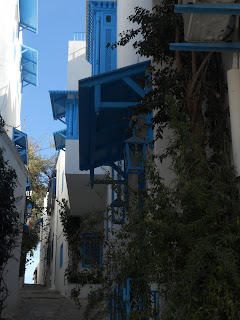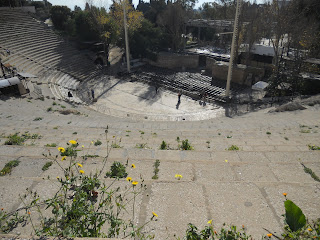
My next destination was Tunisia. I have a friend here who was at Wesleyan last year on a Fullbright, so instead of going back to Colorado, I decided to visit her and before heading back to school. It’s definitely been a lot of travelling and the homelessness is beginning to wear on me, but when else am I going to be able to visit Tunisia? It’s a long way from the US! I can’t help but see it in comparison to Morocco, so I decided to write about what I’ve seen.

Same: the language. Sort of.
Different: The accent. When I arrived, somehow I could understand neither the Arabic not the French. Mushkil Kabir. However, I am getting accustomed, am able to have conversations with Soumaya’s family in French, and am even starting to be able to converse in Arabic. Shwaya shwaya. I think the accent is kind of funny, actually. They have a really drwn out ah sound like the a in apple, so instead of the Moroccan salam that is said like we would say the beginning of salami, they say asalaaama, how are you is shnahawaaaylek, They have a lot of cute words and like to put things in doubles: shwaya shwaya = a little bit; mush mushkl = no problem; safsouf is Souaya’s nickname for her fiancé. A lot of it is very much like Moroccan Darija, but it seems to be taken just a bit farther in terms of cute nicknames and doubling and whatnot. Instead of streetslang, here I am being taught baby talk; nanny is sleep, mommy is eat, kakha is yuck, I think sit was something like shoushi…
Different: I can not longer use certain key phrases. When I say zwina and safi (both awesomely multipurposed in Morocco meaning variations of good/pretty/tasty and enough/already/finished respectively), I just get weird looks. Luckily, shbet (I’m full) still works (though they say shbaat) and there are subsititutes for the others. Akahow will stop the piling of food on my plate, and behi seems to function in a similar way to zwina. I’m working of getting a feel for exactly how they work.
Same: The need for the words shbaat and akahow.

Same: Tea
Different: Table manners. At least in this family, everyone has their own plate, we eat salad with every meal, and I can’t figure out the bread. Sometimes it’s used to pick up food, usually, it’s used to push food onto the fork, and occasionally, it’s just dipped in the sauce. But somehow I seem to be the only one getting my fingers dirty… I guess that’s not different though.
Same: The fact that I feel like I shouldn’t be wandering around alone.
Different: Street harassment—it’s still there, but I’ve gotten way less of it, even walking around by myself. I also saw way more women out and about in Tunis, sitting outside at cafés, sitting on benches, etc.
Same: Cool doors. I think these ones are even prettier, though, or at least there’s more cool ones. I think half my pictures are probably of doors.



Different: Windows. They exist on the outsides of buildings.

Different: Dress code (sort of). No Djelabas. In terms of other street clothing, people dress fairly similar (jeans, sweaters, pea coats, boots, some people wear headscarves) though the jeans tend to be tighter, and these clothes are worn by older generations as well as younger ones. One thing that surprised me, however, was looking at pictures of Soumaya’s engagement party, all her friends are wearing shrot strapless dresses (yes, that was one of the first things I noticed), though she said they all got yelled at by their fiance’s for dancing. She said that most people dance what kind of looked like half-hearted Moroccan dancing, but whenever anyone actually goes all out they think they’re weird.
Same: Everyone changes into their pj’s when they get home. By the way, I fully intend to take this practice home with me.
































